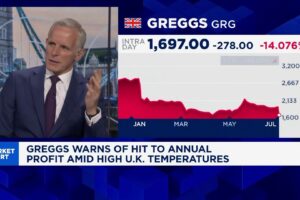We recently compiled a list of the Goldman Sachs’ Best Hedge Fund Stock Picks: Top 20 Stocks. In this article, we are going to take a look at where Microsoft Corporation (NASDAQ:MSFT) stands against Goldman Sachs’ other hedge fund stock picks.
The close of August has marked a highly awaited paradigm shift on Wall Street that investors have been wishing for months. This shift comes after Federal Reserve Chairman Jerome Powell finally admitted that the time for interest rate cuts had come. Investors rejoiced and the flagship S&P index gained 1.15% while the Dow’s blue chip stock index added 1.14% to its value.
Before the Fed chair’s remarks, investment bank Goldman Sachs had already taken a detailed look at the implications of interest rate cuts on the stock market. In a podcast, the bank’s trading strategy head Josh Schiffrin started by explaining that the prospect of the Fed reducing rates was linked “very closely to the performance of short-term bonds.” He however added that it’s “really been bonds that have been responsive, where the story has been quite clear,” pointing out that “the stock market has been range bound and choppy with a fair amount of rotation between different sectors” which leads to index level moves being “muted.” This makes sense when we consider the Dow and S&P’s movements following Powell’s latest comments, as the one percentage point gain for each indicated that investors were well prepared for rate cuts even before the Fed Chair took the stand.
Speaking of the flagship S&P index, GS’ head of American Equity Sales Trading John Flood shared some insights at the June close. Starting off by highlighting the drives of the index’s performance during the first half of the year, Flood outlined that when it came to hedge funds, artificial intelligence and GLP-1 were the two key trends that had driven index returns. He described it as “a long momentum trade” with “both cohorts” of the hedge fund side, namely the “systemic and fundamental long-short” fully involved in trading.
The Goldman equity head also added that retail investors were finally back as well, and they were focused on “focused on the ten biggest stocks in the world.” You can see which companies these might be by reading 20 Largest Companies in the World by Market Cap in 2024. One key concern among investors and analysts alike this year has been a bifurcation in market returns that has seen only the best performers yield most of the rewards. This was also on the mind of analysts from another well known Wall Street bank, who added that it created an opportunity for further profits. Flood shared that while five stocks accounted for “60% of S&P 500’s return year to date,” this sharp divide did not make him uncomfortable.
SEE ALSO 15 Best European AI Stocks According to Morgan Stanley and Best Humanoid Robot Stocks According to Morgan Stanley
The investor flood of optimism surrounding AI, which has pushed the shares of the top AI GPU designer in the world to post an unbelievable 321,150% in all time returns, has also led to worries that the market might be witnessing another period akin to the ill fated dotcom era of the 1990s. When asked whether this period reminded him of that time, Flood replied that his firm felt “a little bit more like 1995 than 1999. And 1995 clearly was a very positive year for the stock market and a positive run,” particularly since “valuations and earnings from market leaders are way friendlier today than they were in 1999.” Concluding by sharing that he felt “very bullish” the analyst also forecast his estimate for the flagship S&P. His estimate? Well, Flood believes that “you could see S&P 500 trade well north of 6,000 this year as the biggest get bigger and we continue to just see a little bit of a news vacuum into the elections right now.”
The bit about market bifurcation between big and small companies was also on the mind of GS’ senior US portfolio strategist Ben Snider. He commented on the jump in small cap stocks in July when they gained as much as 2% while other indexes lost up to 1.98% due to investors positioning themselves for potential interest rate cuts. Snider explained that small cap stocks tend to take on more debt, and lower rates coupled with their lower market values lead to big gains. According to him “if just 1% of assets comes out of the S&P 500 and flows into, for example, the Russell 2000 Small Cap Index, that 1% of S&P 500 market cap would represent more than 15% of Russell 2000 market cap.” Coming back to AI, the Goldman strategist has a tip for those who might be worried that the hype surrounding AI might be more than the technology’s ability to generate money for the firms that plan to plow a trillion dollars into it. He shared that as opposed to the market cap weighted benchmark S&P, it might be prudent to invest in the equal weight variant “if you are concerned about the degree of concentration or AI investment.”
Speaking of AI, GS was also out with a detailed report in July which analyzed the year to date returns of different AI sectors. The AI stack, broadly speaking, is made up of four categories of firms. Starting from the bottom of the pyramid and moving upwards, these are chip manufacturers and designers, those that provide AI capacity like server farms, firms that sell AI products, and finally, companies that will see the largest gains from the ubiquitous or near ubiquitous adaptation of AI. As per GS, the year to date returns of these four sectors as of late July were 139% (represented only by the top AI GPU stock), 22%, -2%, and 2% respectively. One of the strongest performers within the AI infrastructure segment is utilities, and there’s further room ahead as analyst Ryan Hammond believes that “after adjusting valuations for the improvement in long- term EPS growth expectations that the sector has experienced, Utilities’ PEG (P/E to long term growth (LTG)) ratio is 2x, well below the historical average of 3x.”
So, with GS taking a broad view of the market, we decided to see which hedge fund stocks the bank is a fan of.
To make our list of Goldman Sachs’ top hedge fund stocks, we ranked the bank’s list of stocks with the number of hedge funds that, according to its data, had the stock as a top ten holding.
We also mentioned the total number of hedge funds that had bought these stocks as per Insider Monkey’s data. Why are we interested in the stocks that hedge funds pile into? The reason is simple: our research has shown that we can outperform the market by imitating the top stock picks of the best hedge funds. Our quarterly newsletter’s strategy selects 14 small-cap and large-cap stocks every quarter and has returned 275% since May 2014, beating its benchmark by 150 percentage points (see more details here).

A development team working together to create the next version of Windows.
Microsoft Corporation (NASDAQ:MSFT)
Number of Hedge Fund Investors in Q2 2024: 279
GS’ Number Of Funds: 79
Microsoft Corporation (NASDAQ:MSFT) is another big tech giant. Like Alphabet, the firm plays a key role in the artificial intelligence industry, and it benefits from its close partnership with OpenAI – the firm that’s responsible for popularizing AI in the collective imaginations of investors and the general public. While the exact figure isn’t known, what is clear is that Microsoft Corporation (NASDAQ:MSFT) has invested billions of dollars in AI, which means that the technology – and its monetization – are now a fundamental part of the big tech firm’s $3 trillion market capitalization. In fact, Microsoft Corporation (NASDAQ:MSFT)’s enterprise computing business, which accounted for $28.5 billion of its $64 billion in FYQ4 revenue, is another key component of the AI hypothesis as the firm is expected to earn revenue from AI by targeting products to business and enterprise users. In fact, this exposure to enterprise spending has been part of the reason why Microsoft Corporation (NASDAQ:MSFT)’s shares are down by 11% since July while Apple’s shares have lost just 2.89% as investors are increasingly worried about near term AI revenue generation.
Baron Funds mentioned Microsoft Corporation (NASDAQ:MSFT) in its Q2 2024 investor letter. Here is what the firm said:
“Microsoft Corporation is the world’s largest software and cloud computing company. Microsoft was traditionally known for its Windows and Oice products, but over the last five years it has built a $135 billion run-rate cloud business, including its Azure cloud infrastructure service and its Oice 365 and Dynamics 365 cloud-delivered applications. The stock contributed to performance because of continued strong operating results and investor enthusiasm regarding Microsoft’s leadership across the secular megatrends of AI and cloud computing. Recent business momentum continued to show evidence of the strength and attractiveness of Microsoft’s product portfolio among its customer set: (1) Azure OpenAI – its suite of AI services – is now used by 65% of the Fortune 100 and contributed 7% of Azure revenue (an annualized run rate of $5.2 billion); (2) GitHub Copilot – its AI code writing service – is bending the productivity curve for developers (reports of 40%- plus improvements in developer efficiency) and now has 1.8 million paid subscribers, with growth accelerating to over 35% quarter-over-quarter; and (3) Copilot Studio – its AI application service that makes it easier for anyone to build an application, automate a workflow, or create a Copilot using natural language. 30,000 organizations across every industry have used Copilot Studio to customize Copilot for Microsoft 365 or build their own, up 175% quarter-over- quarter. In the March quarter, Microsoft again reported better-than-expected financial results, highlighted by Microsoft Cloud growing 23% year- over-year, with the fastest commercial bookings in six quarters, and Azure accelerating to 31% constant currency growth, up from 28% in the previous quarter. June quarter guidance came in-line with consensus, but the company provided higher guidance for the most important segment, Intelligent Cloud, on the back of continued strong trends across Azure and Azure OpenAI. We remain confident that Microsoft is one of the best- positioned companies across the overlapping software, cloud computing, and AI landscapes.”
Overall MSFT ranks 2nd on our list of Goldman Sachs’ hedge fund stock picks. While we acknowledge the potential of MSFT as an investment, our conviction lies in the belief that some AI stocks hold greater promise for delivering higher returns and doing so within a shorter timeframe. If you are looking for an AI stock that is more promising than MSFT but that trades at less than 5 times its earnings, check out our report about the cheapest AI stock.
READ NEXT: $30 Trillion Opportunity: 15 Best Humanoid Robot Stocks to Buy According to Morgan Stanley and Jim Cramer Says NVIDIA ‘Has Become A Wasteland’.
Disclosure: None. This article is originally published at Insider Monkey.







